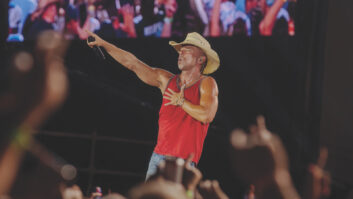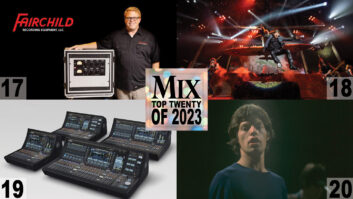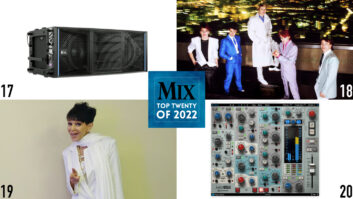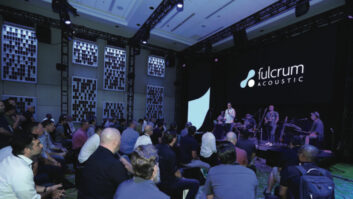by Frank Wells.

The debut single from Kenny Chesney’s 13th studio album, his football tribute single “The Boys of Fall,” has been on the charts for 13 weeks as I write, peaking at number one on Billboard’s country singles list. The album itself, Hemingway’s Whiskey debuted two weeks ago at the top of the Billboard 200 chart. The album is Chesney’s sixth to start at the top of the Billboard 200 and his tenth to reach the top its country album chart.
Chesney’s been off the road in 2010, heading back into the studio to retool the album before its release and traveling around the country filming a companion documentary for “The Boys of Fall,” due for release in November.
At Pro Sound News, we’re usually looking for interviews with the producers and engineers over the artist, but when the opportunity came up to talk with Kenny, I flashed back 15 years and decided to do the interview myself. When he called, I reminded Kenny that we had met previously, when I was the studio tech at Masterfonics. He recorded two albums in Masterfonics’ Studio Six, with Csaba Petocz engineering (I didn’t expect Chesney to remember me—I did my best to be an anonymous piece of the studio infrastructure as far as the artists were concerned). Pete Greene engineered Chesney’s debut album; these first three albums were all produced by the late Barry Beckett, the first at Woodland Sound Studios…
KC: That’s right. Yeah, I still love that Woodland sound. I miss old Barry, man, I really do.
PSN: He was a fabulous musician and just a good soul.
KC: I learned a lot from him, you know. I really did. I’d be in the studio, I’d be in there singing like I was singing in the bars and the clubs, like I was trying to sing over everybody to get somebody to listen to me. Barry goes, “Kenny, you’re doing good, I just want you to get in there and relax and put a smile on.” I’ll be in the vocal booth today, I’ll do a vocal, I’ll go in and listen to it and I’ll sit there and think, “You know what? I need to put a smile on it.” That’s Barry’s influence.
PSN: I watched him so many times doing run downs with musicians and just look around the room and make eye contact and a few hand motions and communicate exactly what he wanted. He was such a musician’s producer.
KC: I would be in the studio, I’d be obsessive with us in there mixing a record, and he was one of the first guys to tell me to leave the studio. He goes—I swear—“Kenny, you can out-think this stuff. If you sit in here and turn knobs all day, you’re going to lose the feel.” He called it mixing the hit out of it. “You’ll mix the hit right out of it.” And he’s right, you know.
PSN: You started working with Buddy Cannon on your fourth album, right?
KC: Yeah, I started working with Buddy Cannon and Norro Wilson. I did two or three with them.
PSN: Right. They were working as a production team in those days.
KC: That’s right and I enjoyed it. Buddy and I have really developed a strong working relationship in the studio. I respect Buddy. Buddy’s song sense has had a big influence on me. He’s been in town a long time and he’s soaked up a lot of wisdom from a lot of songwriters and a lot of life and a lot of living in those songs. I couldn’t imagine doing this without him, because his song sense is incredible and his ear is incredible in the studio. I feel like I get in the studio with these musicians and I can hear in my head how I want it to be, how I want it to sound, but I don’t necessarily know how to translate that, and Buddy knows. I can sit there and talk to the pickers all day and I can hum what I’m hearing and everything, but Buddy has a way of getting it out of them and that’s just years in the studio.
I feel like soaking all that stuff in with guys like Barry and Norro, and especially Buddy, it’s been the biggest musical learning experience in the world. Barry was a great teacher like I said, and Buddy and I have, over the years, got in to the studio and learned. Buddy and [engineer] Justin Niebank predict exactly how I’m going to feel about certain things. There’s been a learning curve with all of us; it’s been a great ride we’ve all been on creatively.
PSN: You’ve mixed with Justin for about three albums now including the Greatest Hits release…
KC: …right. Justin is so talented. On Hemingway’s Whiskey, he kind of knew already where my head was. That was one of the things that doing this record the way we did it and having the luxury of time—we had the opportunity to really talk about music and to really work with the musicians. Buddy and I had a chance to talk a lot about what the songs meant, about how we wanted them to sound production-wise and sonically. I had an album made last summer. I had in my head that I was going to take this year off the road and I wanted this album to be done, too. I went in there with Buddy and Justin and we mixed a record, we mixed a whole album but we didn’t have an album. We had three songs.
I told Justin and Buddy, “We’ve got to go to work and we’ve really got to make this special. Justin was really good. He, as much as anybody, dug in with us. We sat in there and sonically tried to make it fresh and different and still keep who I was as an artist and push my fan base a little bit without me stopping being me.
• • • •
Continue on to Part 2, as Kenny discusses how he balances modern and traditional recording in the studio, what he feels makes Hemingway’s Whiskey stand apart from his previous projects, and more.







